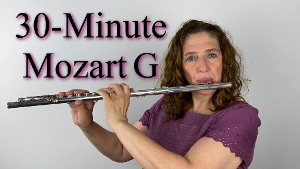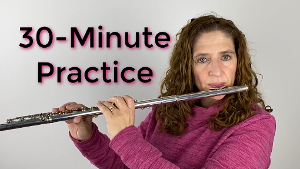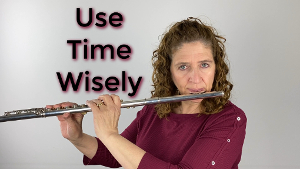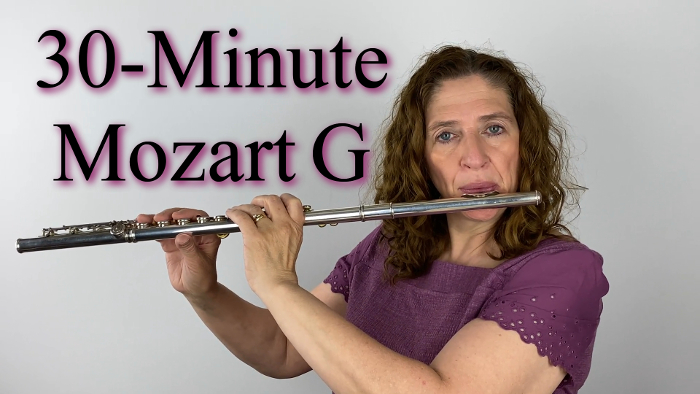You are busy. You don’t have all the time in the world to practice – especially if you’re working a full-time job, and perhaps it’s not even in music. But you still want to improve, you want to get better. You come home and you have dinner to get, or kids to cart here and there, and all you can really carve out from your day is 30 minutes to practice. Well, I think that you can use those 30 minutes to practice only your solo AND cover tone/technique and etude as well as musical solo practicing in that short amount of time.
It does take a little bit of creative work. But it can be done. The benefit you gain is that you are learning your solo while you are practicing.
Technique
I am going to begin with technique which means scales and arpeggios. Guess what? Mozart concertos are chuck full of scales and arpeggios. To begin, notice that this concerto is in G. That means I will begin by playing my G major scale, I want to know the G major arpeggio, and I want to play the G major scale in thirds.
Play though your G major scales then play it in 3rds. Then play the G major arpeggio. Get comfortable with the scale in 3rds it’s a great way to practice you scales. Play these until you whip up and down the scales like no bodies business. Additionally, play the D scale 3rds and arpeggios. Because on close inspection, there are places where Mozart moves to the dominant key of D major.
This G major concerto, as in many classical pieces and concertos like this one, is largely based on scales, arpeggios, and scales in thirds. So, if you know those cold, so much technique will be easy for you.
After I’m done playing scales and arpeggios, I will look in the concerto itself and find scales passages or arpeggios in the music. Take a couple sections at a time and work on the scale patterns Mozart uses. Put your metronome on and make sure you are even. Sometimes the scales aren’t just straight up and down. But you are looking for sections of adjacent notes. When you have those under your fingers, find another couple sections and work on those. After that, do the same with arpeggios. Mozart uses arpeggios.
This is the approach for technique. I’m sure you can see where I’m going with this and you can easily apply it to your own practice.
Tone
You are now warmed up after all those scales and arpeggios. Now it is time to work on your tone. So, let’s look at the second movement. We’ll do a couple of things with practicing tone at the same time as your solo because we’ve only got 30 minutes. So, let’s look at the solo in your second movement. It’s a gorgeous movement that you can use for tone practice. Let’s begin by taking out the first five notes to use as a tone exercise.
First, I’ll take that A at the beginning and play it until I get the tone that I want. Then I move to all 5 notes to play very slowly compared to how I would normally play it. Am I smooth? Are there any glitches? How is my vibrato? Am I tapering at the end? How is my vibrato going through that taper? Am I keeping my embouchure open so that the tone sounds mellifluous and beautiful? Now perhaps I will move on to the next group of notes and do the same thing.
Flexibility/Articulation
Now, another thing that I like to do when I’m doing a 30-minute practice time using a solo such as this Mozart Concerto in G is to work on my articulation and my embouchure movement.
So, we’ve covered technique. We’ve covered tone. Now let’s do some articulation because we need to practice articulation and embouchure flexibility. In the first movement there are some great spots where Mozart wrote articulated octaves. He wrote then in 8ths, triplets, and 16th notes. These are great spots to work on that embouchure and its flexibility. Take those sections out of context. Play them with the best tone and do the octave jumps maintaining that sound. Work on short crisp articulations at the same time.
Etude
This entire concerto can be considered an etude. Etudes usually work on a specific area. And this concerto does the same thing. Using all the 16th note passages and practicing with the metronome, and using lots of different articulations is exactly what you would do in an etude. Once done you put those passages back into context and work on the musical line and phrasing.
Solo
Well now you can finally work on all the little spots that didn’t fit in with your other categories. Here is where you play a section and listen for continuity and other spots that need work. But you know what? All that other work pays off here.
So that’s my advice. If you have a very difficult time eking out that practice time, try this method. Use your solo, use it wisely. You can learn your solo and improve all skill areas at the same time!
Have fun!
DoctorFlute
Watch me demonstrate this: 30-Minute Practice Session Using Mozart Concerto in G – FluteTips 134

What to Do in a 30-Minute Practice Session – FluteTips 119

How to Warm Up in 15 Minutes – FluteTips 152

Using Your Practice Time Wisely – FluteTips 156

